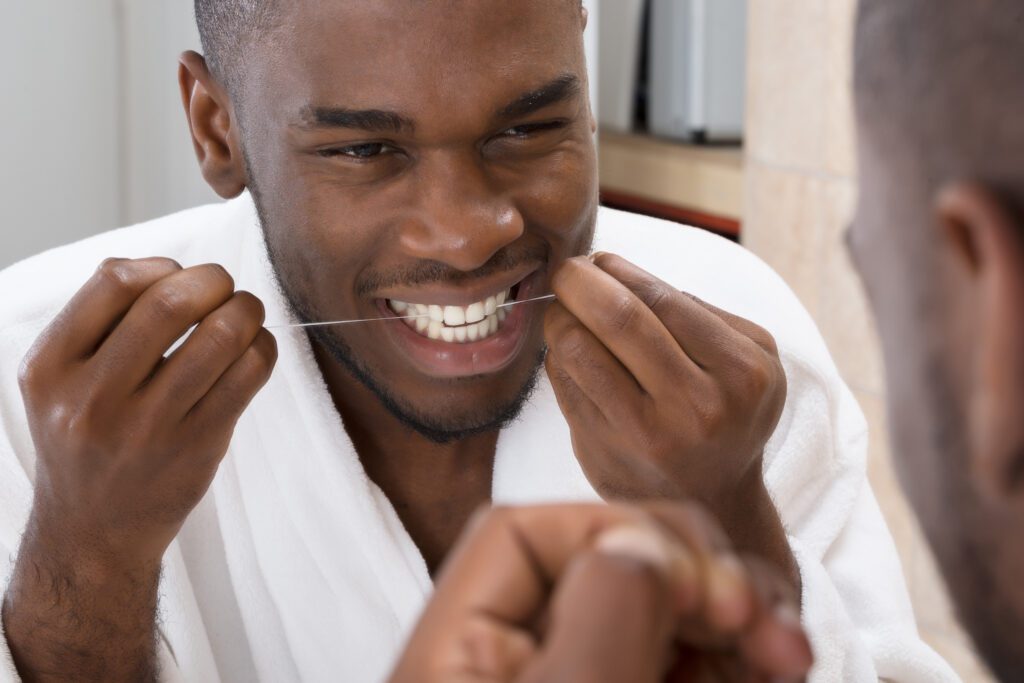October is National Dental Hygiene Month, and we are thrilled. Of course, we think every month is dental hygiene month, but we’ll embrace a national celebration where we can get it. In honor of the distinction, we highlight four ways to preserve and promote your dental hygiene.
Oral or dental hygiene is the practice of keeping your mouth healthy and clean. It is critical for those who want to preserve the integrity of their teeth, avoid halitosis, and even maintain overall bodily health. Any bacterial infection or oral disease can be transferred through the bloodstream to other parts of the body, so oral health is whole-body health. Good dental hygiene comes down to good preventative care, keeping your teeth and gums healthy to prevent infection or disease and to delay decay.

Brush Properly
Of course this one is number one. We all know the importance of brushing your teeth if you want to maintain good dental hygiene. However, it is important to understand that brushing one’s teeth is not just about swiping a toothbrush across your molars at bedtime and calling it good. You should brush your teeth twice a day at the very least. Spend a significant amount of time on each tooth, cleaning the fronts, tops, and backs with circular motions of the toothbrush.
An important facet of the brushing process includes brushing your tongue. The tongue, as unpleasant as the concept is, acts as a large sponge in your mouth. It soaks up bacteria and the acids and juices you consume in a day, so giving it a thorough scrub is a necessity in terms of a good dental hygiene routine. It is also very important to brush your gums to prevent infection and gum disease.
Another tool in the brushing arsenal is dry brushing. Brushing your teeth without toothpaste allows you to dislodge debris no matter where you are, and you can spend more time doing it without toothpaste in your mouth. Dry brush is best used as a supplement to regular tooth brushing.
Floss Sufficiently
Flossing is a notoriously underused avenue to good dental hygiene. The places where teeth meet tend to hide debris and food particles that cannot be dislodged with regular brushing. Flossing is the only way to keep these spaces clean before bacteria has an opportunity to grow unchecked. Flossing should be completed at least once a day, though flossing more regularly is better at dislodging debris early on.

Flossing works by wrapping a piece of dental floss, roughly 18 inches long, around each of your middle or index fingers. From there, using mainly your thumbs to guide the strand of floss, insert the floss between two teeth, wrap it around one tooth in the shape of a C, and clean the tooth using about 10 up and down strokes. Switch to the other tooth and repeat. The entire process should be repeated for all of your teeth. Be sure to rinse the piece of floss each time you remove it.
For those who are looking for convenience or less required dexterity, dental picks are also available. This constitutes a small plastic handle and a piece of floss strung in between. While they are much easier to hold and navigate, it is important to rinse picks the same way you would a piece of floss. This limits the risk of redistributing bacteria from one section of the mouth to the other.
Have Regular Dental Visits
We understand that visiting the dentist is not on par with Disneyland in terms of excited anticipation. However, for those who really champion their dental hygiene, it should perhaps inspire more delight. Mickey Mouse cannot help you discover dental defects before they’re a problem, and Peter Pan isn’t likely to make ADA recommended product suggestions specific to your oral health. Make visiting the dentist every six months a priority for thorough cleanings and to receive dental care tailored to you.
Be Careful of What You Put In Your Mouth
Again, the body is many systems working together in intricate ways. Everything you put in your mouth is sure to affect not just your mouth but everything else as well. While sugary churros (sorry Disneyland) may not give you diabetes, they will increase the bacterial feeding frenzy on your teeth. Sugar consumption is directly linked to cavity levels
If you care about your oral health, avoid products like tobacco and nicotine. Smoking is a leading cause of gum disease and oral cancer. Even vaping e-cigarettes draws nicotine into the body where it can wreak havoc. It’s best to avoid nicotine and tobacco altogether. If you are looking to quit either of these products, help and resources are available.

If you’re looking for something you can put in your mouth that’s good for your oral hygiene, start with water. Water helps to flush out debris, bacteria, acids, and toxins from your mouth. You also need it to survive, so err on the side of drinking more, not less.
Good dental hygiene can mean that you avoid the worst effects of tooth decay, gum disease, oral sores, cavities and toothaches, but it is so much more. It also means you can feel great when you smile into the mirror, knowing that your mouth is healthy and happy. For more suggestions on how to maintain good dental hygiene, speak to your dentist today.
